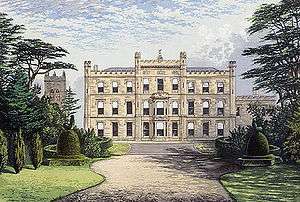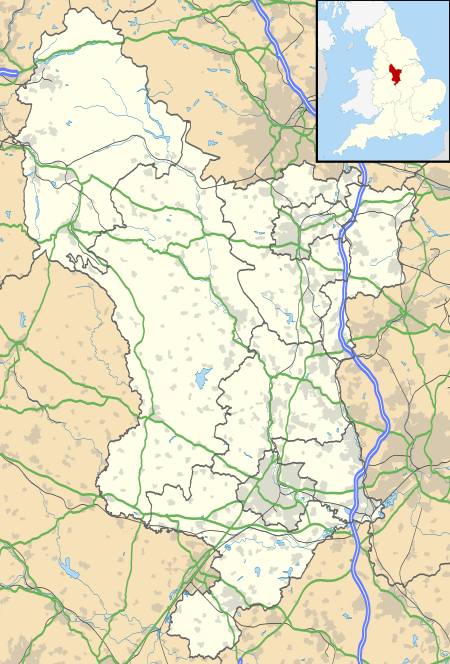Elvaston Castle
Elvaston Castle is a stately home in Elvaston, Derbyshire, England. The Gothic Revival castle and surrounding parkland is run and owned by Derbyshire County Council as a country park known as, Elvaston Castle Country Park. The country park has 200 acres (0.81 km2) of woodlands, parkland and formal gardens.
| Elvaston Castle | |
|---|---|
 Elvaston Castle in the late 19th century | |
 Location within Derbyshire | |
| General information | |
| Architectural style | Gothic Revival |
| Location | Elvaston, Derbyshire |
| Country | England, United Kingdom |
| Coordinates | 52°53′34″N 1°23′43″W |
| Construction started | 1815–1829 (Extended and Remodeled) |
| Completed | 1836 (Final Alterations Completed) |
| Owner | Earl of Harrington Derbyshire County Council |
| Design and construction | |
| Architect | James Wyatt, Robert Walker, Lewis Nockalls Cottingham |
Listed Building – Grade II* | |
| Designated | 2 September 1952 - House 4 August 1984 - Park |
| Reference no. | 1334604 - Country House 1000404 - Park and Garden |
Listed Building – Grade II | |
| Number of Listings | 14 including Boat House, Coach House, Grotto and Moorish Temple[1] |
The centrepiece of the estate is the Grade II* Listed Elvaston Castle. The castle has been neglected and has fallen into disrepair; due to its condition, the building is not open to the public, and since 2008 has been listed on the Buildings at Risk Register.[2][3] Derbyshire County Council estimates the castle and estate requires at least £6.1 million of work and materials in essential repairs, with a maximum permitted overspend of 7% greater if it is decided to re-open the building to the public or sell it in repaired form.[4]
History

Until the 16th century the estate was held by the Shelford Priory. After the Dissolution of the Monasteries the Crown sold the priory and its estates in 1538 to Sir Michael Stanhope of Rampton, Nottinghamshire.[5] Sir John Stanhope (died 1611) granted the estate to his second son, also Sir John Stanhope (d .1638), High Sheriff of Derbyshire, in 1629.
The manor house was built for the latter Sir John in 1633. This Elizabethan-style house was redesigned and extended in a grand Gothic Revival style by James Wyatt in the early 19th century for the Charles Stanhope, 3rd Earl of Harrington.[6] Wyatt designed a new wing, a new great hall, and most of the interiors of the castle, but died before work was completed.[6] His designs were carried out by Robert Walker between 1815 and 1829.[6]
Further modifications were made in the 1836 by the architect Lewis Nockalls Cottingham; this work was on the Elizabethan-styled south front which was remodelled to match the rest of the now Gothic-styled castle.[6]
This was the final modification and created the castle we see today.[6]
During World War II, the house was turned into a teacher training college after the original college in Derby was evacuated.[6]
The college vacated the house in 1947, after which time it remained mostly empty for the next two decades until its sale, starting a steady decline that continues to this day.[6]
The Gardens

The 3rd Earl, approached Humphry Repton to remodel the grounds of the Castle, however, Repton turned down the commission due to the flatness of the estate, which he found daunting.[6]
In 1830, Charles Stanhope, 4th Earl of Harrington commissioned the previously untried landscape gardener William Barron, to redesign the gardens.[6] The Fourth Earl caused scandal by marrying an actress 17 years his junior: Maria Foote.[6] Maria and Charles are described as "inseparable and besotted"; the Earl wanted the gardens to be a "private and secluded oasis of great beauty" for himself and the love of his life.[6] Barron would spend the next 20 years working on the gardens; he even brought in full-grown trees to try to give instant gratification to the Earl.[6]
The Fourth Earl and his Countess valued their garden for the romantic seclusion it afforded them, however following the death of their only son aged 4, the couple isolated themselves at the castle, never leaving and forbidding anyone from entering the grounds. (Some sources claim it was the Earl that instigated the seclusion and forbade his wife from leaving)[6][7]
Following the Fourth Earl's death in 1851, his brother, Leicester Stanhope, 5th Earl of Harrington, opened the gardens to the public.
They became renowned as "a Gothic paradise", and are Grade II Listed.[6]
The estate contains over 50 structures, including stables, kennels, a walled garden, a home farm, several cottages, gatelodges, an ice house and a boathouse.[3]
The gardens are listed Grade II* on the Register of Historic Parks and Gardens.[8]
Country park
Following the Countryside Act 1968, the estate was sold in 1969 by William Stanhope, 11th Earl of Harrington to Derbyshire County Council.[9] The Countryside Act proposed the creation of "country parks", "for the enjoyment of the countryside by the public". The council opened the estate to the public in 1970 and have operated it since then, as Elvaston Castle Country Park.[2]
In 1969, Elvaston was also used as a location for Ken Russell's film adaptation of the D.H. Lawrence novel Women in Love.
Today

The country park is threatened with closure.[9]
The deterioration of the castle and estate which started after World War II continued under the care of Derbyshire County Council; by 1990 the castle was considered unsafe and was closed to visitors.[6] Derbyshire County Council claims that it cannot afford to repair and maintain the building and country park; in the year 2000, the council estimated the country park's running costs were £500,000 a year, and that they were facing a backlog of restoration work which would cost them £3,000,000.[6]
Since 2000, the council has been marketing the estate for sale to private companies.[9] The latest of these is an attempt to turn the Castle into an hotel and the Park into golf courses.[9] This is being fiercely contested by "The Friends of Elvaston Castle" on behalf of the local community.[9]
The £3,000,000 repair work needed in 2000 was not performed; the continued lack of funding from the county council has led to much of the country park and estate to fall into disrepair.[3] The castle is in need of considerable restoration and is not open to the public; since 2008 has been listed on the Buildings at Risk Register.[2][3]
Derbyshire County Council acknowledges the "ever increasing backlog of maintenance and outstanding repair work". The cost of repair work has spiraled and as of November 2010, the council estimates the castle needs £6.422 million of work and materials in essential repairs (This figure includes a 7.5% contingency but does not include non-essential repairs, decoration or furnishing).[4][10]
Hauntings
The castle is thought by some to be haunted: various professional investigations have been conducted in the castle, with phenomena being reported including unexplained noises, unexplained apparitions, people being pushed and things being moved.[11] The ghosts are alleged to include a maid and 'a strong woman'.[11]
The castle is also supposed to be the haunt of two ghosts known as The Grey Lady, and The White Lady.[7] The White Lady is supposed to be the ghost of Maria, wife of the 4th Earl; she has been seen sitting in the windows of the castle, and walking the grounds with a white dog.[7]
The haunting atmosphere of the castle has inspired at least one gothic "novel" entitled "Elvingstone" by J.P Reedman.
See also
References
- "Historic England (search for "Elvaston Castle")". historicengland.org.uk. Retrieved 28 June 2016.
- Elvaston Castle Country Park - official Derbyshire County Council site
- ElvastonCastle.org.uk - Information about Elvaston Castle, Derbyshire
- http://www.derbyshire.gov.uk/images/11-05-06%20Elvaston%20Vol%201%20Intro%20and%20Exec%20Summary_tcm44-174384.pdf
- "STANHOPE, Michael (by 1508-52), of Shelford, Notts., Kingston-upon-Hull, Yorks. and Beddington, Surr". History of Parliament. Institute of Historical Research. Retrieved 12 August 2013.
- "The History of Elvaston Castle and Grounds". Retrieved 28 July 2011.
- Derby Ghosts and Paranormal - Elvaston Castle Ghosts Ghosts Archived 2013-03-26 at the Wayback Machine
- Historic England, "Elvaston Castle (1000404)", National Heritage List for England, retrieved 21 November 2017
- Friends Of Elvaston Castle
- Elvaston repairs: Leisure and culture - Derbyshire County Council
- Wadd, Barbara (2007). More Ghost Walks in Derbyshire. Wiltshire: Cromwell Press. ISBN 978-1-85983-556-2.
- English Heritage:Images of England, architectural description (1952) of listed building
- Magna Britannia, Volume 5 Derbyshire (1817) p. 142
External links
| Wikimedia Commons has media related to Elvaston Castle. |
![]()
